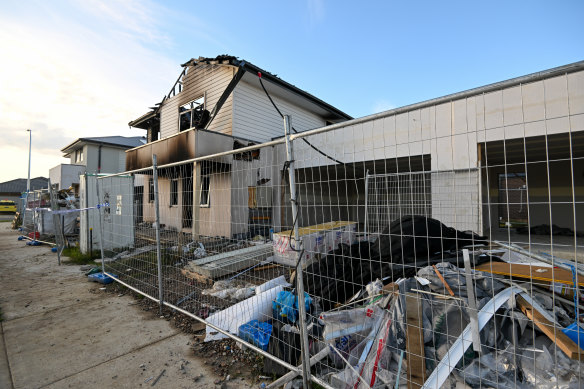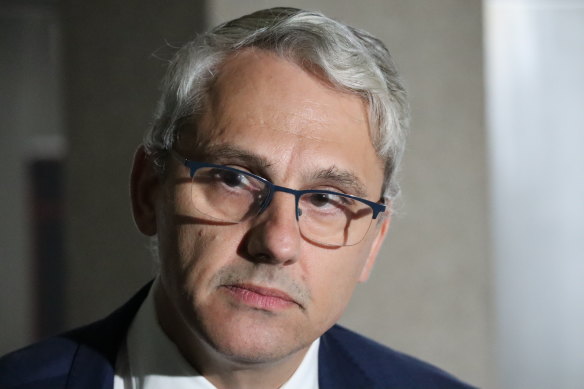This was published 3 months ago
Home builder’s collapse blows hole in state insurer’s finances
The collapse of building giant Porter Davis has blown a hole in the finances of the state-backed insurance agency, forcing the government to contemplate a bailout and straining the Victorian budget amid expectations of premium rises for state departments, hospitals and major projects.
Issues with the Victorian Managed Insurance Authority, which covers $235.7 billion worth of state assets and oversees domestic building insurance, have created a funding challenge for the Allan government as it seeks to rein in debt.

The collapse of Porter Davis put a strain on the Victorian Managed Insurance Authority.Credit: Joe Armao
New documents obtained by the state opposition under freedom-of-information laws show the VMIA was placed under significant financial pressure last year after major increases in costs, prompting proposals to increase premiums or consider state government intervention.
Ministerial briefs show the agency’s funding ratio fell from 131 per cent in June 2021 to 103 per cent in June 2023. If this figure falls below 100 per cent, the cost of paying out claims is more than the amount of cash being generated. The agency has adopted a “capital management plan” to return its finances to more sustainable levels so that it can withstand further shocks.
The hit to the VMIA’s budget was partly driven by $300 million in unexpected payouts made to victims of the October 2022 floods and to those affected by the collapse of building giant Porter Davis in March 2023. The VMIA estimates responding to the Porter Davis insolvency lowered its funding ratio by 5 per cent.
In response, the state government stopped collecting dividends from the VMIA and cancelled a plan to take $50 million out of the agency. Assistant Treasurer Danny Pearson was warned a strategy was needed to improve its finances.
Premiums for domestic building insurance, which provides cover for home owners who are building or renovating, were increased by 43 per cent on September 1, 2023, to manage costs.
The minister was told the state might need to provide a cash injection to the agency as one option to keep its funding ratio above 100 per cent.
This was ultimately avoided, but further advice was provided about charging higher premiums on government departments and projects in the next financial year, noting this would probably be paid through the state budget.
“The primary response to improve the VMIA’s financial position beyond the impact of the actions taken, and recommended to date, is the pricing of government business,” one brief says.

Assistant Treasurer Danny PearsonCredit: Gus McCubbing
“It is likely that government departments will seek funding for any material premium increases through the 2024-25 budget process.”
Further documents show the VMIA expects a 13 per cent increase in premium revenue in 2024-25 as fees are increased, bringing in an extra $74 million. Premiums are expected to grow by at least 7 per cent up to 2028, when the scheme expects it will bring in $800 million annually.
Contacted by The Age, the VMIA said its 2024-25 charges on government business were not yet finalised and a decision would be announced before June 30.
“VMIA has a capital management plan that aims to return the insurance funding ratio to the
middle of the preferred range,” a spokesman said.
“Various actions are under way and will continue to be monitored. These include ceasing
dividend payments to the state and reviewing premium settings to more closely reflect
frequency and cost of claims.
“VMIA has not received any capital injections. Our financial position is sound and we can pay
all liabilities as they fall due without needing funding from the government.”
On average, the agency estimates its charges are 50 per cent lower than competitors in the commercial market.
The Age revealed in January that the VMIA had 1359 outstanding domestic building claims awaiting settlement, after receiving a year’s worth of cases in a single month of 2023. Customers have also complained about delays or rejections in their claims.
Opposition finance spokeswoman Jess Wilson said the government should explain how premiums will be increased and the impact on the state’s debt.
“These documents show that under Labor, the state’s public insurer faces the very real prospect of being unable to meet its financial obligations in a sustainable way,” she said.
“Whether through a taxpayer-funded bailout, cuts to insurance coverage or even further premium hikes, Victorian taxpayers will ultimately pay the price of Labor’s financial mismanagement of the VMIA.
The agency’s operating costs in 2023-24 were also projected to increase by 8 per cent more than originally expected, driven by increased wages, taxes and WorkCover premiums. It is expected to improve its funding ratio to 111 per cent by 2027-28.
Get the day’s breaking news, entertainment ideas and a long read to enjoy. Sign up to receive our Evening Edition newsletter here.